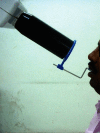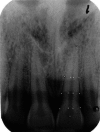Age estimation using maxillary central incisors: A radiographic study
- PMID: 23741151
- PMCID: PMC3669486
- DOI: 10.4103/0975-1475.109897
Age estimation using maxillary central incisors: A radiographic study
Abstract
Background: In the field of forensic dentistry, secondary changes in teeth with advancing age have been used as reliable predictors of age in various studies.
Aim: The purpose of the present study was to present a method for assessing the chronological age based on the relationship between age and morphological parameters of maxillary central incisors.
Materials and methods: Fifty subjects between 20-70 years of age were included in the study. Intraoral periapical radiographs were taken in relation to maxillary central incisors using paralleling technique. The following measurements were recorded: lengths of tooth, pulp, root and width of root and pulp at three different points. Regression formulas were used to calculate the dental age.
Results: The mean estimated age showed no statistically significant difference from the actual mean age (P > 0.05). Also, maximum difference was seen for root length variable (-1.035 ± 1.86 years).
Keywords: Age estimation; central incisors; forensic identification; radiographic study.
Conflict of interest statement
Figures
References
-
- Barsley RE. Forensic and legal issues in oral diagnosis; Topics in oral diagnosis II. Dent Clin N Am. 1993;37:133–56. - PubMed
-
- Jain AK, Chen H. Matching of dental X ray images for human identification. Pattern Recognition. 2004;37:1519–32.
-
- Pateel DG. Efficacy of pulp/tooth area ratio in age estimation by using radiographs of permanant canine: A preliminary study. Indian J Forensic Odontol. 2009;2:21–4.
-
- Singaraju S, Sharada P. Age estimation using Pulp/tooth ratio: A digital image analysis. J Forensic Dent Sci. 2009;1:37–41.
LinkOut - more resources
Full Text Sources


